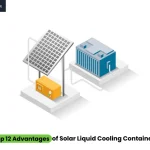Commercial Hybrid Energy Storage Systems offer a paradigm shift in energy resource management. These systems harness the promise of renewable energy sources while assuring a dependable and resilient energy supply by combining the power of cutting-edge battery technology, smart inverters, and intelligent energy management.
What are Commercial Hybrid Energy Storage Systems?
Commercial Hybrid Energy Storage Systems, or Commercial HESS, are a complex and adaptable system meant to transform the way organizations manage and use electrical energy. These systems integrate numerous components and technologies to efficiently store and distribute energy, giving many significant benefits.
Commercial Hybrid Energy Storage Systems, at their heart, are modern energy storage solutions that seamlessly integrate several components to maximize the generation, storage, and distribution of electrical energy for commercial and industrial applications. In contrast to typical energy storage systems, which frequently depend simply on batteries, Commercial HESS combines numerous elements to provide a resilient and adaptive energy management infrastructure.
Components of Commercial Hybrid Energy Storage Systems
- Battery Storage: Batteries are the primary storage medium in Commercial HESS. These systems use high-capacity, generally lithium-ion batteries to efficiently store extra energy. The stored energy is easily accessible during high demand periods or when renewable energy sources are not producing power.
- Inverters and Power Electronics: Inverters are essential components that transform direct current (DC) energy stored in batteries into alternating current (AC) electricity. AC power is the most common type of energy used in business establishments and is required to run appliances and machines. Power electronics are also important in controlling the flow of power inside the system.
- Energy Management Systems (EMS): The EMS is a complex control system that continually analyzes and controls the many parts of a Commercial Hybrid Energy Storage System. It improves system performance by making real-time decisions based on criteria such as energy output, consumption patterns, and grid circumstances.
Integration with Renewable Energy Sources and the Grid
One of the distinguishing characteristics of Commercial Hybrid Energy Storage Systems is their ability to seamlessly integrate with renewable energy sources and the electrical grid:
- Renewable Energy Integration: Commercial hybrid systems frequently function in tandem with renewable energy sources like solar panels or wind turbines. When these sources provide extra energy, it is stored in batteries. This stored renewable energy may then be used when renewable energy output is low, making the facility more self-sufficient and sustainable.
- Grid Connection: These systems are often linked to the local power grid. They can interact with the grid in a variety of ways, such as selling excess energy back to it or pulling electricity from it when renewable energy supply is insufficient. This grid link gives businesses more flexibility and energy management alternatives.
Advantages of Commercial Hybrid Energy Storage Systems
These systems are often connected to the local power grid. They can interact with the grid in a variety of ways, such as selling excess energy back to it or pulling electricity from it when renewable energy supply is insufficient. This grid link gives businesses more flexibility and energy management alternatives.
Cost Savings and Energy Efficiency
Commercial Hybrid Energy Storage Systems are designed to reduce energy consumption by storing extra energy during periods of low demand or cheaper energy costs, which results in considerable cost savings and efficiency.
When demand peaks or energy costs rise, the stored energy can be released, eliminating the need to purchase power at higher prices. Lower power costs occur, especially in areas with time-of-use pricing or demand charges.
Energy efficiency is also improved since these technologies allow enterprises to maximize their renewable energy sources. Excess renewable energy created under ideal circumstances is stored for later use when paired with solar panels or wind turbines, eliminating waste and maintaining a continuous energy supply.
Reliability and Backup Power
For organizations, especially those with sensitive equipment and activities that require a constant power supply, reliability is non-negotiable. Commercial Hybrid Energy Storage Systems are a strong alternative for increasing reliability and providing backup power during grid interruptions.
These systems can easily convert to stored energy in the case of a power outage or grid breakdown, providing uninterrupted power to important loads. This functionality is extremely useful in businesses where even a brief power outage might result in significant losses. A solid backup power supply is vital in any data center, hospital, or manufacturing organization.
Environmental Benefits and Sustainability
Commercial Hybrid Energy Storage Systems serve an important role in fostering a greener energy ecosystem. Businesses can minimize their dependency on fossil fuels, reduce greenhouse gas emissions, and contribute to a more sustainable environment by combining renewable energy sources such as solar or wind with energy storage.
Furthermore, the capacity to store extra renewable energy and use it when needed eliminates the need for backup generators, which frequently run on fossil fuels. This shift to cleaner energy sources is consistent with business sustainability goals, governmental mandates, and the expectations of environmentally concerned customers.
Grid Stability and the Role of These Systems in the Broader Energy Landscape
Commercial Hybrid Energy Storage Systems benefit not just individual enterprises but also the overall stability and resilience of the energy system. They contribute significantly to grid stability in numerous ways:
- Frequency Regulation: These devices can respond quickly to changes in grid frequency, assisting in grid stabilization. When the grid frequency lowers owing to increased demand or a sudden loss of power output, the stored energy can be swiftly released to rebalance the system.
- Peak Shaving: These devices relieve strain on the electrical infrastructure by lowering peak demand from the grid during peak usage periods. This, in turn, can lessen the demand for grid upgrades and result in a more stable electricity supply for all users.
- Enhanced Integration of Renewable Energy: Energy storage devices smooth out the unpredictability of renewable energy sources such as solar and wind because they are inherently intermittent. This predictability and consistency help grid operators manage energy flows more effectively and integrate additional renewables into the grid.
In short, Commercial Hybrid Energy Storage Systems provide several benefits such as financial savings, energy dependability, environmental responsibility, and grid stability. These technologies have the potential to change the way organizations consume and manage energy, therefore contributing to a more sustainable and resilient energy landscape.
Applications and Use Cases
Commercial Hybrid Energy Storage Systems offer a wide range of real-world applications, proving their adaptability and usefulness in a variety of settings. We will dig into the practical applications and use cases of these systems in this part, highlighting their influence on many areas of the economy and the energy environment.
1. Commercial and Industrial Applications
- Optimizing Energy Costs: Electricity costs are significant for many commercial and industrial enterprises, especially during peak demand hours. Commercial Hybrid Energy Storage Systems provide a solution by storing extra energy during off-peak hours and releasing it during peak hours. Businesses may save a lot of money by using effective energy management.
- Grid Support and Reliability: To ensure ongoing operations, commercial facilities require a dependable power supply. During power outages, these systems can serve as a backup power source, guaranteeing business continuity and protecting important equipment and operations.
- Reducing Environmental Impact: Companies in a variety of industries are becoming more devoted to lowering their carbon impact. Commercial and industrial operations may dramatically reduce greenhouse gas emissions and contribute to sustainability goals by combining renewable energy sources with energy storage.
2. Microgrids and Behind-the-Meter Installations
- Microgrid Resilience: Microgrids are small-scale energy systems that can run alone or in cooperation with the main power grid. Microgrids may sustain power supply during grid failures by including energy storage, making them an essential component of important infrastructure such as hospitals, data centers, and military facilities.
- Behind-the-Meter Efficiency: Energy storage devices installed behind the meter are intended for self-consumption and demand control. Businesses can use extra energy provided by renewable sources to power their operations during peak hours. This method minimizes grid demand, resulting in decreased electricity costs and increased energy efficiency.
Successful Implementations
- Walmart’s Energy Storage Initiative:
Walmart, the world’s largest retailer, has installed Commercial Hybrid Energy Storage Systems in a number of its shops and distribution sites. These solutions assist the firm in lowering its energy expenditures and improving grid stability, resulting in considerable cost reductions and a decrease in peak demand prices.
- Hospital Microgrids:
To deliver critical healthcare, hospitals and healthcare institutions rely on consistent power. Many hospitals have installed microgrids with energy storage to provide uninterrupted power supply, even in the event of a natural disaster or a power outage.
- Data Center Energy Efficiency:
Data centers, which are notorious for their excessive energy use, are turning to energy storage to better regulate their power consumption. Case studies from top data center operators show the importance of energy storage in lowering operational costs and impact on the environment.
- Remote Area Electrification:
Hybrid energy storage systems are used to supply reliable electricity in distant places where grid access is restricted. Case studies from off-grid villages and isolated industrial sites demonstrate how these technologies provide access to power while also promoting economic growth and improving living circumstances.
Important Considerations when Implementing a Hybrid Energy Storage System
To guarantee a successful deployment, business organizations must carefully evaluate a variety of criteria.
- Energy Needs Assessment: It is critical to do a detailed energy needs assessment before deploying a hybrid energy storage system. This evaluation should take into account aspects such as historical energy use, peak demand patterns, and special operating requirements.
- Energy Goals and Objectives: Define your energy-related goals and objectives clearly. Are you mainly interested in lowering energy prices, improving grid reliability, or meeting environmental goals? A comprehensive grasp of your goals will aid in system selection and customization.
- Consultation with Experts: Collaboration with experienced energy consultants and engineers can be invaluable. These experts can assess your unique situation, recommend suitable technologies, and help design a system tailored to your specific needs.
- Cost-Benefit Analysis: Determine the hybrid energy storage system’s probable return on investment (ROI) and payback period. Consider the initial investment, ongoing maintenance costs, and the anticipated savings from lower energy bills and grid services.
- Optimal Sizing: It is vital to select the appropriate size for your energy storage system. System oversizing or undersizing can result in inefficient operation or missed opportunities. System size should be based on your energy consumption trends and operational needs. Consider future expansion and rising energy demand as well.
- Local Regulations: Regulations governing energy storage and grid connections differ by location and country. Check that your system conforms with local and national rules, as well as safety and environmental standards.
Conclusion
These systems provide a long-term solution for commercial enterprises seeking to cut energy costs, improve dependability, and contribute to a greener future. Commercial companies can meet their energy demands as well as environmental obligations by utilizing these amazing energy storage solutions.
Smart Energy Gap offers commercial hybrid energy storage systems that represent a watershed moment in the energy sector, providing a versatile and long-term solution for enterprises and industries alike.



